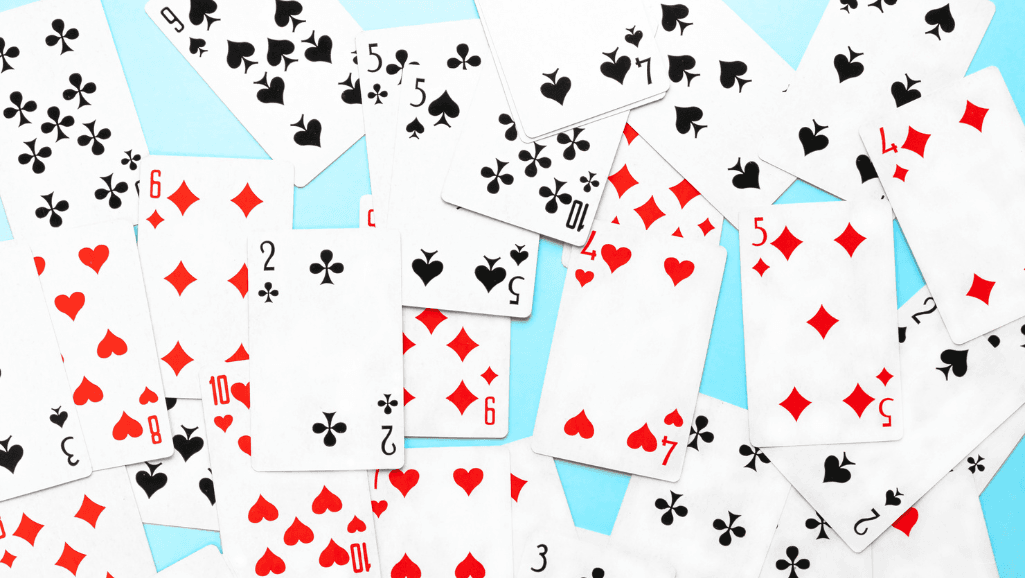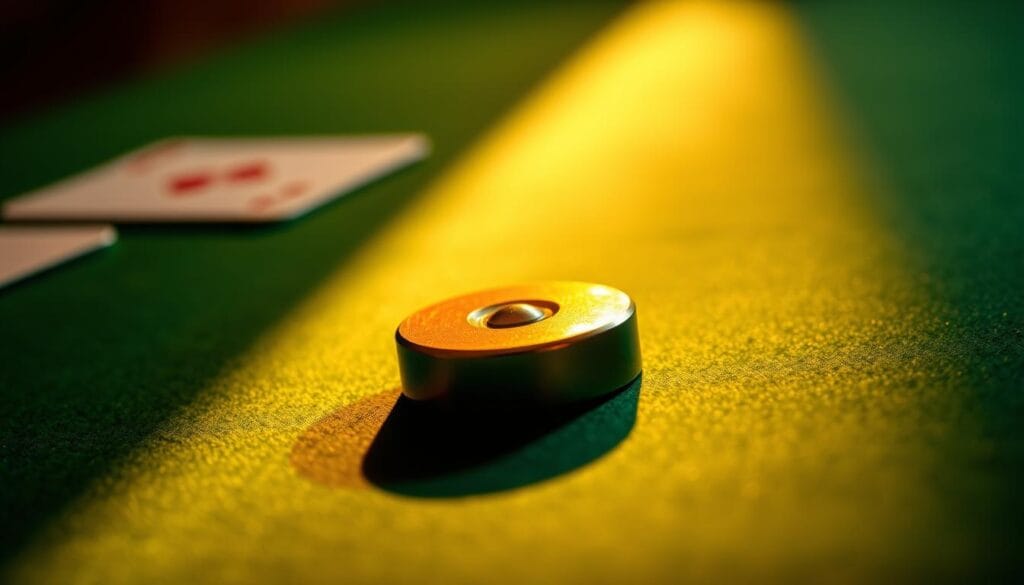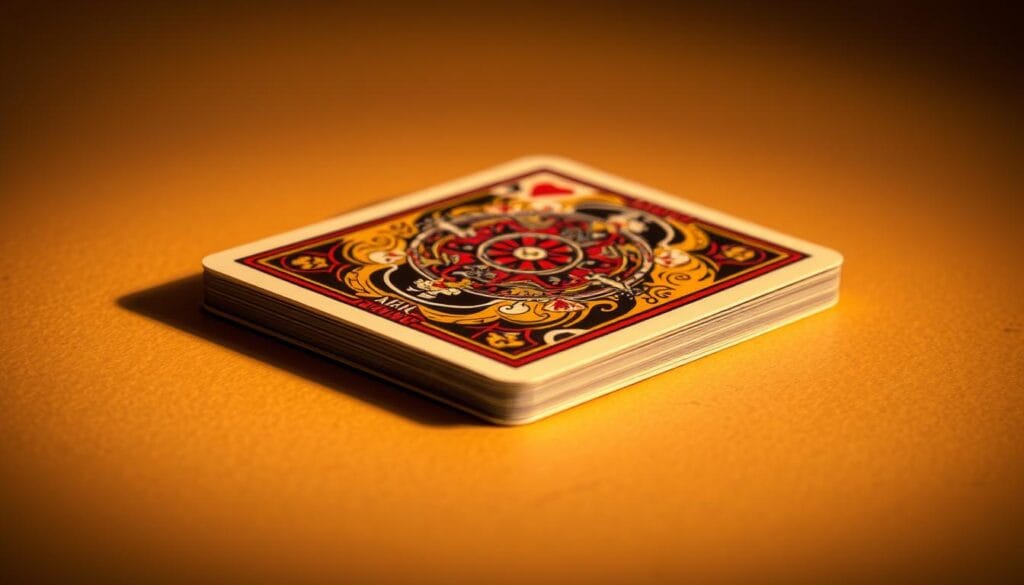Euchre is a fast, social trick-taking pastime that suits casual nights at the table or friendly tournaments. Four players sit in two teams of two and use a 24-card deck made from 9 through Ace. The goal is clear: race to ten points by winning the majority of five tricks each hand.
Naming trump reshapes every suit and changes who holds the power in a hand. One partner calls trump and must claim at least three tricks, while the opposing team defends. Special rules elevate the Jacks as the top trumps, so recognizing those cards can turn a weak hand into a winning one.
Play moves quickly: the dealer’s left leads first, winners lead next, and scoring awards 1 point for a 3–4 trick maker, 2 points for a sweep, and bonus points for going alone or for an opponent being euchred. With clear tempo and teamwork, you can learn basic strategy and feel confident at the table within a few rounds.
Key Takeaways
- how to play euchre card game.
- Four players form two teams and use a 24-card deck.
- The first team to ten points wins the match.
- Naming trump shifts suit strength and decisions.
- Right and Left Bowers (Jacks) are the top trumps.
- Winners of tricks lead the next play for tempo.
- Going alone can yield big rewards but carries risk.
What Is Euchre? A Quick Overview for New Players
This classic trick-taking pastime gives four players tight, tactical rounds around the table. It is a fast-paced card game played in partnerships. Each hand has five tricks and rewards clear choices and teamwork.
Setup and flow: Deal five cards to each player and turn up one card. Players then decide whether that suit becomes trump or the option is passed. The team that names trump are the Makers; they must win at least three tricks. The opposing team, the Defenders, aim to stop them. Play proceeds clockwise and each trick reshapes the round.
- Think of euchre as a brisk five-trick race of momentum and timing.
- With just 24 cards, every card played yields quick, useful clues.
- Order up, pass, or go alone—these choices set the stakes before the first lead.
- The first team to reach ten points wins, so each round matters.
Deck, Setup, and Table Basics
A crisp, 24-card pack and clear scoring make each round fast and fair. Create your deck by removing 2–8 from a standard set. Keep 9, 10, J, Q, K, A in each suit for a tight, tactical pack.
Scoring is simple and visual. Set aside two 5s in the same color for each team. Slide and flip pips after each hand so points are obvious at the table.
Seat partners opposite one another so turns rotate evenly and play stays smooth. Keep the center tidy with a dedicated spot for the turn-up card and trick piles.
- Create a compact card deck for brisk hands and clear reads.
- Use your scoring fives or a notepad if you prefer digital tracking.
- Agree on house rules up front and shuffle thoroughly for balanced deals.
Teams, Seating, and Choosing the Dealer
Organized seating and a predictable dealer cycle set the stage for each brisk round. Four players form two teams and sit opposite each other. This layout makes turn order clear and keeps partners focused on shared goals.
Starting player, dealer rotation, and around-the-table flow
Pick the first dealer by drawing a high card. After that, the dealer role moves clockwise each hand so every person shares duties.
The starting player is always the person left of the dealer. That player leads the first trick and sets tempo for the round.
“Clear seats and steady rotation let a table move fast and stay fair.”
- Form two teams of two and sit opposite for clean turn order.
- Keep the deck and turn-up card visible in the center of the table so choices are informed.
- Confirm order and use calm, confident calls like “pass,” “order it up,” or “alone.”
Dealing in Euchre: Hands, Turn-Up Card, and Order of Play
A brisk, orderly deal sets the tempo for every round at the table. The dealer shuffles, then deals five cards to each player in two packets—commonly 2 then 3 or 3 then 2—always moving clockwise and beginning with the player on the dealer’s left.
After the deal, place the remaining deck in the center and flip the top card face up as the turn-up card. That face-up card becomes the potential trump for the hand.
Give everyone a moment to sort their cards and arrange suits for quick reads. The order of action moves clockwise; the first decision to accept or pass starts with the player left of the dealer.
- Deal five cards in two packets, always clockwise.
- Turn the top card of the leftover deck face up as potential trump.
- Once trump is set, the starting player to the dealer’s left must lead the first card.
Tip: Keep dealing consistent and swift. When the dealer manages the turn-up with confidence, partners can visualize a plan and chase three tricks with purpose.
Naming Trump: Order It Up, Pass, and Stick the Dealer
The face-up card starts a quick negotiation around the table for which suit will rule the hand. Players act in turn, beginning with the person left of the dealer and moving clockwise. That single exposed card is the prompt: accept it or pass.
From face-up card to open call
In the first round each player may say “Order it up” or pass. If someone orders it up, the dealer takes the face-up card and discards one from their hand.
If all four pass, a second round begins. Any suit except the turned-down suit may be named as trump in this round. Many tables use a house rule called stick the dealer, which forces the dealer to choose a suit if everyone passes again.
Who are the Makers and Defenders?
The team that names the trump suit are the Makers and must win at least three of five tricks. The opposing team are the Defenders and aim to stop them.
“Decide with courage, but respect timing — position around the table changes pressure.”
- Assess the face-up suit and your partner’s actions before committing.
- Ordering it up makes the dealer manage the extra card and discard.
- When unsure, remember a risky call can hand the Defenders two points.
- Strong hands might warrant a lone call after naming the trump suit.
Trump Ranking Explained: Right Bower, Left Bower, and Highest Card
One pair of Jacks can reorder the entire strength of a hand in an instant. In the trump suit the Jack of that suit is the Right Bower and is the highest card. The Jack of the same-color suit becomes the Left Bower and counts as trump as well.
The full trump ranking runs: Right Bower, Left Bower, Ace, King, Queen, 10, 9. For example, if hearts are trump, J♥ (Right) then J♦ (Left) lead the list.
Why the Left Bower changes suit
The Left Bower legally joins the trump suit because it shares color with the Right Bower. That means jack diamonds can act as a heart when hearts are trump. Spotting this swap helps you follow suit correctly and avoid illegal plays.
Non-trump suit ranking when no trump is played
When no trump appears in a trick, the led suit ranks Ace down to 9: A, K, Q, J, 10, 9. In those moments, protect your top suits and use trump later to seize control.
- Tip: Train your eye to find the Left Bower fast.
- Example: With spades trump, J♠ then J♣ dominate.
- Practice: Lay out mock hands and memorize the order.
Following Suit, Suit Led, and How a Team Wins a Trick
Following the lead is the firm rule that anchors every trick at the table. When a player places a card on the table, that suit led sets the obligation for others. If you have at least one card of that suit, you must play it.
If you are void in the suit, you may play any other card. This includes a trump card, which beats any non-trump in that trick. The highest trump played wins trick; if no trump appears, the highest card in the suit led takes it.
“The winner of each trick earns the right to lead the next one — seize momentum when you can.”
- Respect the suit led: follow it when you can; that is fair and strategic.
- When void, consider a trump card to steal the trick or shed a loser.
- The highest trump wins; otherwise, the highest card in the suit led wins.
- Watch your partner and preserve key trumps; do not overtrump a teammate.
- Track which suits are exhausted so a single low trump can flip a trick later.
Leading, Table Etiquette, and Fair Play
Winning a trick hands you the lead and the responsibility to steer the round with purpose. Make that choice quickly and confidently. A crisp lead sets tempo and protects a partner’s likely winners.
Respect the table. Verbal or nonverbal hints about holdings are off limits. Fair play keeps contests honest and fun for every person at the table.
Order matters: Play proceeds clockwise and each player must follow suit when able. If you are void in a suit, consider using a trump or discarding wisely to probe opponents.
“Pause briefly before leading; think what your last card showed and what you want to hide.”
- Lead with purpose: draw trump, protect partner, or test for voids.
- Collect won tricks face down in a tidy pile for easy counting.
- Resolve any misplay using agreed house rules before the next lead.
Good etiquette sharpens skill. Keep decisions brisk, treat every player with respect, and let strong play speak louder than signals.
Going Alone: When and Why to Play Without Your Partner
A confident solo call can flip a close match overnight. The player who names trump may opt to go alone, leaving the partner out of active play for that hand. This bold choice raises the stakes and can change the points balance fast.
Risk and reward: If the solo Maker wins all five tricks, the team earns 4 points. Winning three or four tricks scores 1 point. If the lone player wins fewer than three, Defenders pocket 2 points.
Pick solo only when your trump and overall suit coverage give a clear path to many tricks. Visualize each winning card and how it unlocks the next play.
“Declare alone when the odds favor a sweep—but accept that a single misread can cost your team badly.”
- Declare “alone” when trump strength and position can realistically sweep five tricks.
- Often only the caller may go alone; the partner sets cards aside.
- A solo sweep yields 4 points; a 3–4 trick result gives 1 point; failing nets Defenders 2 points.
- Isolate bowers and aces, avoid telegraphing holdings, and respect your partner by choosing equity over ego.
Scoring to Ten Points: Marches, Euchres, and Point Values
Points shape choices each hand and steer teams toward the ten-point finish. Keep the ladder of rewards and penalties clear so each decision matches the risk at the table.
Makers versus Defenders: who scores and when
Makers earn 1 point when they take three or four tricks. A full five-trick sweep, called a march, awards Makers 2 points.
If the Makers fail to reach three tricks, they are euchred and the Defenders collect 2 points. A lone Maker who sweeps all five tricks scores 4 points for the team.
Recording points with the fives
Many groups use two physical 5s per team. Slide or flip pips after each hand so the score stays visible and obvious.
- Commit the scoring ladder: 1 point (3–4 tricks), 2 points (march), 2 points to Defenders if euchred.
- Solo sweep = 4 points; it can swing a match fast.
- Only the team that called trump scores for Maker success; Defenders score by stopping them.
- Review the five tricks, count who wins trick, then update the tally before the next deal.
“At 8 or 9 points, one bold call can decide the match—choose with purpose.”
Keep score clearly, watch tipping points, and use the fives for quick reads. When the dealer turns the card or names a suit, remember what the ledger demands and act for steady gains rather than flashy risk in the final stretch of the game.
Sample Round: From Turn-Up Card to Five Tricks
See how a full five-trick round flows, from the face-up card through the final count.
The starting player, left of the dealer, evaluates the turn-up and leads once trump is set. Around the table each person reacts, follows the suit, or uses a trump if void.
Walkthrough of a hand
Suppose Diamonds are trump and Hearts are led. A player may win by trumping with the jack diamonds or any higher trump. That play often wins trick and seizes control.
If Clubs are trump and Clubs are led, J♣ (Right) defeats J♠ (Left), showing how bowers decide in-suit fights. Remember the Left Bower adopts the trump suit, so it follows when that suit is led.
- The winner of each trick immediately leads the next; tracking who wins trick matters for tempo.
- Watch which suits—spades, hearts, clubs—vanish; a timely trump flips control with a modest card.
- After five tricks, count who wins trick totals, score the hand, and shuffle for the next round.
“Log high trumps in your head and decide whether to draw bowers or hold them as stoppers.”
Strategy to Win More Tricks: Smart Leads and Partner Play
A confident initial lead can strip away opposing strength and reveal weaknesses. Use the first plays to shape the hand, not just react.
Leading trump, flushing out bowers, and saving a stopper
Open with a trump lead when you suspect opponents hold a bower. That flushes powerful cards early and clears a path for your aces.
Keep one stopper trump for the penultimate or final trick. That reserve often decides a close finish when the last trick wins trick points.
Laying off and protecting your partner’s winning card
If your partner’s play is already high, avoid overtrumping. Laying off preserves strength and builds later control.
Watch partner signals in the way they lead; a confident off-suit lead may hide a planned trump strike.
Reading the table and card counting in a short deck
Track both bowers and aces; in a 24-card pack, missing pieces are obvious fast. Count suits played and note voids.
- Probe with mid cards to find voids.
- Use position: last to act can see what a player plays and react.
- Mix leads: sometimes draw trump, sometimes build side-suit winners.
House Rules and Variations You Might Encounter
Before cards hit the felt, confirm which variant your group prefers for the night.
Most casual tables use Knock Euchre: there is no auction. Players simply order up or pass and the round moves on. Many groups add a stick the dealer rule that forces the dealer to name a trump suit if everyone passes twice.
Some clubs use Bid Euchre, where players bid for rights to name trump and the auction adds strategy and pressure. Other tables include a Joker as the top trump card, which shifts endgame choices dramatically.
Clarify whether the dealer’s partner can name trump or is required to go alone under local rules. Also agree on dealing style (2-3 vs. 3-2), misdeal handling, and penalties for reneges before you begin.
“Agree on one set of house rules and stick with it for a fair, fun night.”
- Expect Knock Euchre at most casual tables.
- Bid variants add an auction layer for trump rights.
- Ask about Joker use and dealer-partner calling rules.
- Confirm scoring, dealing style, and penalties up front.
how to play euchre card game: Step-by-Step Quick Start
Ready for a quick flow that gets your table moving with confidence? The round starts by building a neat 24-card deck, seating partners opposite, and naming a clear dealer. A swift setup keeps momentum and helps every player focus.
- Shuffle the 24 cards and deal five to each player; the dealer flips one face up.
- Going clockwise, each person may pass or order the card trump; if ordered, the dealer picks it up and discards.
- If all pass, a second naming round begins and a different suit may be chosen.
- With trump set, the player left of the dealer leads; each player plays in turn and must follow the suit led when able.
- Play five tricks, count winners, update score, rotate the dealer, and start the next round.
Remember: when a player plays a late trump it can flip a trick. Keep score with fives so your team wins the race to ten with steady, inspired choices.
Conclusion
Mastery begins when strategy meets quick, confident decisions at the table.
You now hold the essentials: the 24-card engine, naming trump, and how bowers reshape power. Each hand is a compact contest; five tricks per round make every choice meaningful.
Lead with intent and follow with discipline. Read your partner and protect their winners. Count trumps and track each suit so a single timely play can decide a close hand.
Keep score and adapt your style. Explore variations, agree on house rules, and deepen experience by playing often. For a clear rules reference, visit official euchre rules and review the card rankings and scoring.
,
























